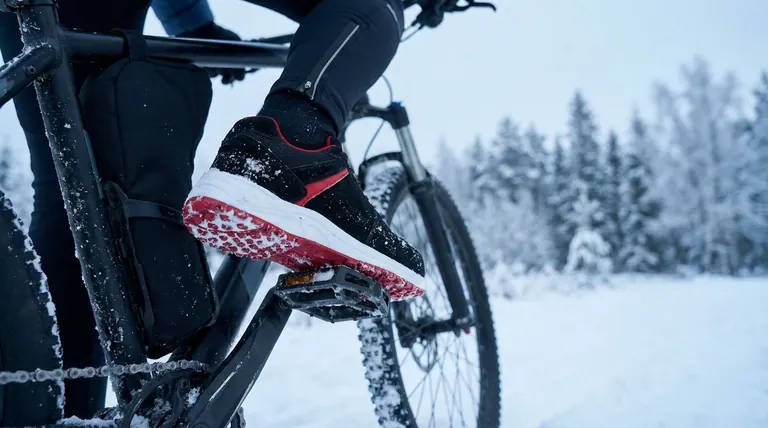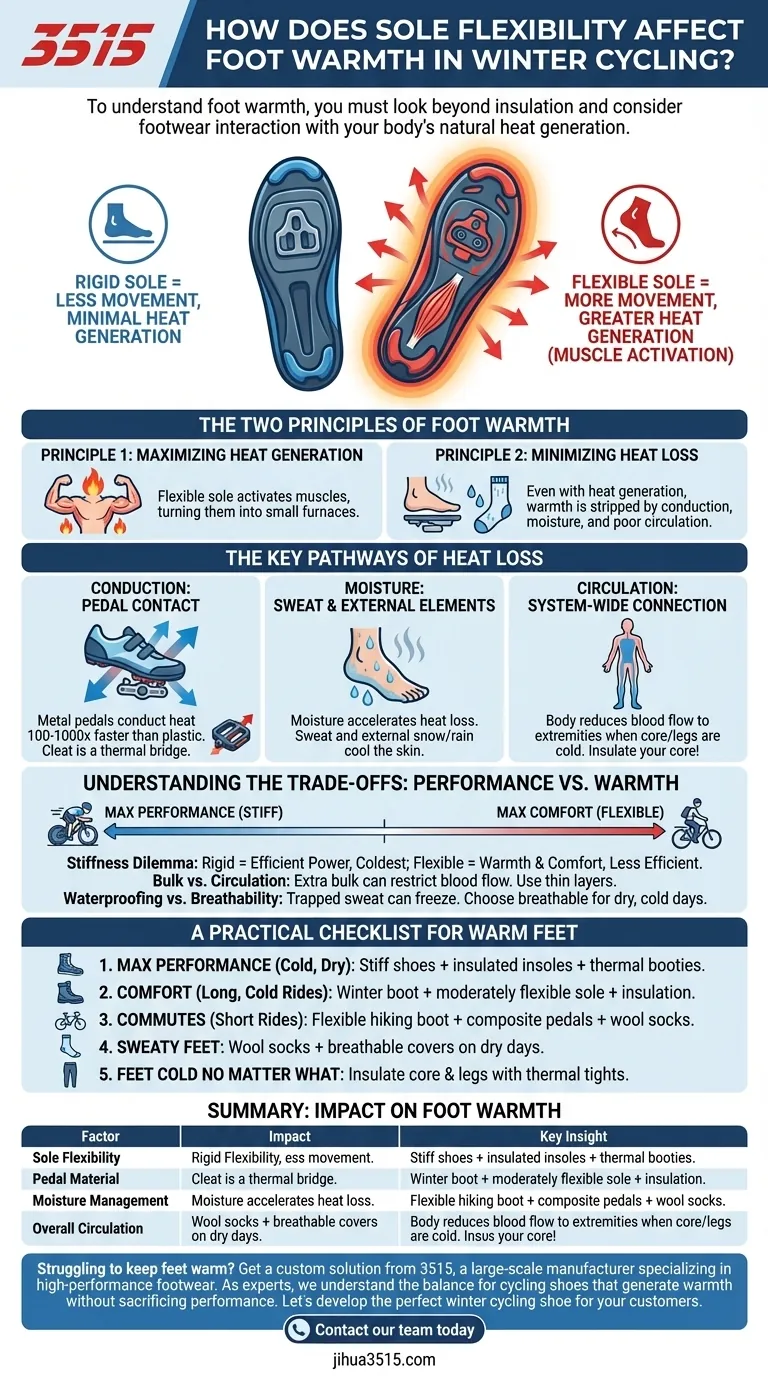To understand foot warmth in winter cycling, you must look beyond insulation and consider how your footwear interacts with your body's natural heat generation. A more flexible shoe sole allows for greater foot movement and muscle flexing while pedaling and walking. This muscular activity generates significantly more heat than the static position forced by a rigid, high-performance cycling sole.
While a flexible sole aids in natural heat generation, keeping your feet warm is a systems problem. The most significant factors are preventing heat loss through conduction to your pedals, managing moisture, and ensuring proper blood flow from a warm body core.

The Two Principles of Foot Warmth
Solving the cold-foot puzzle requires balancing two competing forces: your body's ability to generate heat and the environment's relentless effort to take it away.
Principle 1: Maximizing Heat Generation
Your body's primary source of warmth is metabolic heat generated by muscle activity.
Cycling is a relatively low-intensity activity for the foot's small muscles, which is why feet get cold so easily. A flexible sole encourages more movement within the foot, activating these muscles and turning them into small furnaces. A stiffer sole, designed for maximum power transfer, immobilizes the foot and minimizes this crucial source of warmth.
Principle 2: Minimizing Heat Loss
Even a foot working hard to generate heat will get cold if that warmth is immediately stripped away. Understanding how you lose heat is critical. The primary culprits in cycling are conduction, moisture, and poor circulation.
The Key Pathways of Heat Loss
You can have the best insulation in the world, but if you ignore these three pathways, your feet will inevitably get cold.
Conduction: The Cold Reality of Your Pedals
Conduction is heat transfer through direct contact. Your shoe's cleat and the pedal act as a highly efficient thermal bridge, pulling warmth directly out of your foot.
Metal pedals are especially problematic, conducting heat 100 to 1,000 times faster than plastic or composite pedals. This makes pedal material one of the single most important factors in foot warmth.
Insulated insoles made of closed-cell foam can create a barrier, but heat will still find a path through the metal cleat and bolts.
Moisture: The Enemy Within and Without
Moisture is a thermal accelerator. A wet foot will lose heat dramatically faster than a dry one, primarily from sweat but also from external snow or rain.
Sweat cools the skin through evaporation, and the moisture itself conducts heat away from your foot into your sock and shoe. Waterproof covers can block external moisture but may trap sweat, creating a cold, clammy environment inside.
Circulation: The System-Wide Connection
Your feet are at the periphery of your circulatory system. If your body's core, hips, or legs get cold, your body will instinctively reduce blood flow to your extremities to conserve heat for your vital organs.
No amount of foot insulation can make up for poor circulation. If your upper legs are cold, your feet will be cold. It's that simple.
Understanding the Trade-offs: Performance vs. Warmth
Choosing the right winter cycling setup involves balancing competing priorities. What works for a racer is often the opposite of what's needed for a comfortable commuter.
The Stiffness Dilemma
A stiff, carbon-soled shoe is ideal for efficient power transfer. However, this rigidity prevents the muscle flexion needed for heat generation, making it the coldest option. A more flexible sole sacrifices some peak efficiency for significantly more warmth and comfort.
The Bulk vs. Circulation Balance
Adding thick socks or multiple layers of booties seems like an obvious solution, but it can be counterproductive. If this extra bulk makes your shoes too tight, it will compress your foot and restrict blood flow, making your feet even colder.
A thin silk or merino liner sock paired with a medium-weight wool sock often provides more warmth than a single bulky sock if space is tight.
Waterproofing vs. Breathability
Waterproof booties or socks are essential for wet conditions. However, on cold, dry days, they can trap all the sweat your feet produce. This internal moisture can then freeze, making your feet colder than if you had used a more breathable, non-waterproof cover.
A Practical Checklist for Warm Feet
Use this guide to match your strategy to your specific needs.
- If your primary focus is maximum performance on cold, dry days: Stick with your stiff-soled shoes but add insulated insoles and thermal booties to combat conductive heat loss without sacrificing power transfer.
- If your primary focus is comfort on long, cold rides: A dedicated winter cycling boot with a moderately flexible sole, built-in insulation, and a windproof/water-resistant exterior is the best investment.
- If your primary focus is short commutes or casual rides: A flexible-soled hiking boot or winter shoe paired with flat, composite (plastic) pedals and warm wool socks is often the most effective and simplest solution.
- If you struggle with sweaty feet: Prioritize moisture management with high-quality wool socks and avoid fully waterproof shoe covers on dry days to allow sweat to escape.
- If your feet get cold no matter what: Ensure your core, hips, and legs are adequately insulated with thermal tights, as poor circulation is the most likely root cause.
Ultimately, treating foot warmth as a complete system—from your core temperature down to your pedal material—is the key to comfortable winter riding.
Summary Table:
| Factor | Impact on Foot Warmth | Key Insight |
|---|---|---|
| Sole Flexibility | Increases heat generation | Flexible soles allow muscle movement, acting as small furnaces. |
| Pedal Material | Major conductive heat loss | Plastic/composite pedals are 100-1000x better than metal. |
| Moisture Management | Critical for heat retention | Wet feet lose heat dramatically faster; wool socks help. |
| Overall Circulation | System-wide connection | Cold core/legs reduce blood flow to feet, making them cold. |
Struggling to keep feet warm on your winter rides? Get a custom solution from 3515, a large-scale manufacturer specializing in high-performance footwear.
As experts in producing comprehensive ranges of footwear for distributors, brand owners, and bulk clients, we understand the precise balance needed for cycling shoes that generate warmth without sacrificing performance. Our production capabilities encompass all types of shoes and boots, including technical cycling footwear designed for harsh conditions.
Let's develop the perfect winter cycling shoe for your customers. Contact our team today to discuss your needs and how we can bring reliable, warm footwear to your market.
Visual Guide

Related Products
- Premium Suede Sport Safety Shoes for Wholesale & Bulk Orders
- Premium KPU Athletic Safety Shoes for Wholesale
- Heavy Duty Nubuck Safety Boots Safety Shoes for Global Distribution
- Premium Sport Style Safety Boots for Bulk Orders
- Wholesale Training Shoes with Dial Lacing System Custom OEM Manufacturing
People Also Ask
- What is the importance of wearing safety shoes in the workplace? Protect Your Team and Your Bottom Line
- What are the key safety features to consider when choosing work boots? Ensure Maximum Protection for Your Job
- Why is it important to select breathable and supportive materials for work boot uppers? Enhance Safety and Comfort
- What factors should be checked when trying on safety shoes? Ensure Perfect Fit & Maximum Protection
- What safety boots are recommended for the construction industry? Ensure Maximum Protection on the Job Site



















